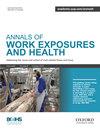346 Planning for growth: occupational hygiene capability
IF 1.8
4区 医学
Q3 PUBLIC, ENVIRONMENTAL & OCCUPATIONAL HEALTH
引用次数: 0
Abstract
ILO estimates that each year a total of 160 million new cases of work-related illness occur globally (35 million due to exposure to chemicals) and 2 million lives are lost to occupational disease (3% of all deaths). How do we as a community grow the occupational hygiene skill base to manage this risk? In 2006, concerned at the slow growth in occupational hygiene capability, a group of senior occupational hygienists with global reach met to consider options. Their report was circulated widely and presented at International Conferences and IOHA and National Association meetings. With input and contributions from across the world, a series of modular training packages were developed. In 2009, the Occupational Hygiene Training Association (OHTA) was formed to run this program under the IOHA umbrella. This talk will cover how OHTA evolved, what it offers and how it complements and supports other programmes to develop and grow occupational hygiene capability. For the last 15 years, its resources have been used by occupational hygienists across the world for the training and development of the next generation of occupational hygienists. As OHTA enters the next phase of its evolution, hear latest developments and how you can become part of this program “Uniting Occupational Hygiene Professionals at a Global level to protect worker health”346 增长规划:职业卫生能力
据国际劳工组织估计,全球每年共新增 1.6 亿例与工作相关的疾病病例(其中 3500 万例因接触化学品所致),200 万人因职业病丧生(占死亡总人数的 3%)。作为一个社区,我们如何发展职业卫生技能基础以管理这一风险?2006 年,出于对职业卫生能力发展缓慢的担忧,一个由全球资深职业卫生学家组成的小组召开会议,考虑各种方案。他们的报告被广泛分发,并在国际会议、IOHA 和国家协会会议上进行了介绍。根据世界各地的意见和建议,开发了一系列模块化培训包。2009 年,职业卫生培训协会 (OHTA) 成立,在 IOHA 的保护伞下运行该计划。本讲座将介绍职业卫生培训协会是如何发展起来的,它提供了哪些服务,以及它是如何补充和支持其他计划以发展和提高职业卫生能力的。在过去的 15 年中,世界各地的职业卫生学家一直在利用其资源培训和培养下一代职业卫生学家。随着 OHTA 进入下一个发展阶段,您将了解到最新的发展情况,以及如何成为这项 "在全球范围内团结职业卫生专业人员,保护工人健康 "计划的一部分。
本文章由计算机程序翻译,如有差异,请以英文原文为准。
求助全文
约1分钟内获得全文
求助全文
来源期刊

Annals Of Work Exposures and Health
Medicine-Public Health, Environmental and Occupational Health
CiteScore
4.60
自引率
19.20%
发文量
79
期刊介绍:
About the Journal
Annals of Work Exposures and Health is dedicated to presenting advances in exposure science supporting the recognition, quantification, and control of exposures at work, and epidemiological studies on their effects on human health and well-being. A key question we apply to submission is, "Is this paper going to help readers better understand, quantify, and control conditions at work that adversely or positively affect health and well-being?"
We are interested in high quality scientific research addressing:
the quantification of work exposures, including chemical, biological, physical, biomechanical, and psychosocial, and the elements of work organization giving rise to such exposures;
the relationship between these exposures and the acute and chronic health consequences for those exposed and their families and communities;
populations at special risk of work-related exposures including women, under-represented minorities, immigrants, and other vulnerable groups such as temporary, contingent and informal sector workers;
the effectiveness of interventions addressing exposure and risk including production technologies, work process engineering, and personal protective systems;
policies and management approaches to reduce risk and improve health and well-being among workers, their families or communities;
methodologies and mechanisms that underlie the quantification and/or control of exposure and risk.
There is heavy pressure on space in the journal, and the above interests mean that we do not usually publish papers that simply report local conditions without generalizable results. We are also unlikely to publish reports on human health and well-being without information on the work exposure characteristics giving rise to the effects. We particularly welcome contributions from scientists based in, or addressing conditions in, developing economies that fall within the above scope.
 求助内容:
求助内容: 应助结果提醒方式:
应助结果提醒方式:


